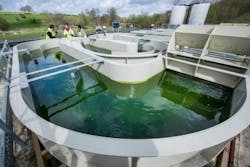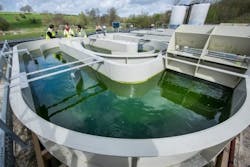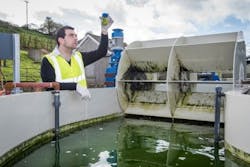Algae farms could offer more sustainable water treatment, finds study
BATH, UK – Algae ponds are being used to remove nutrients and treat wastewater in a joint project between the University of Bath and utility Wessex Water.
The project is investigating utilising algae ponds to treat wastewater and reduce levels of phosphorus - an increasingly key concern for the UK’s water utility companies, with pressure from the Environment Agency to find new solutions due to the Water Framework Directive (WFD).
The current trial aims to use a ‘managed eutrophication’ approach. Rather than allowing wastewater to release nutrients which encourages algae to grow in the watercourse and cause damage, algae are grown at the sewage treatment works in a managed way and removed before the water enters the river.
This results in “polished” wastewater that can then be released into the river, and algae biomass which can be recovered and used as a resource.
To achieve this, a pilot High-Rate Algal Pond (HRAP) system has been installed at Wessex Water’s sewage treatment works (STW) in Beckington,
The trial is treating approximately 3,000 litres of wastewater per day, while removing 80-96 percent of the phosphorus present. The system at Beckington consists of two shallow ponds with a total functional area of 60m2 and capacity of 18,000 litres, where wastewater is continuously circulated by paddlewheels.
The HRAPs are seeded with the desired species of algae and fed with final wastewater effluent, which would otherwise be released into the environment.
Within each pond, algae use nutrients in the wastewater, sunlight and carbon dioxide to grow, thereby reducing overall nutrient levels including phosphorous.
A proportion of the water and algae mixture is then moved to a settling tank and separated daily, while fresh effluent is added to top up the ponds.
This results in “polished” wastewater with lower levels of harmful nutrients which can be returned to the environment, and algae rich in nutrients that can be used for various purposes such as bioplastics, biofuel and agricultural fertiliser.
Thus, by using this system algae can be grown in a managed way and removed before wastewater reaches the river.
The team, led by Dr Tom Arnot in the University’s Department of Chemical Engineering and Professor Rod Scott in the Department of Biology & Biochemistry.
Dr Dimitrios Kaloudis, Research Associate in the University of Bath’s Department of Biology & Biochemistry and operator of the trial at Beckington, said: “In theory, HRAPs could offer an environmentally friendly and sustainable way of removing phosphorus from wastewaters and consequently improving the health of our rivers and lakes without a massive increase in consumer’s water bills.
“In this trial, one of the first of its kind, we are looking to establish how the technology performs in realistic scales and conditions as well as to understand and address any challenges that may arise during the course of the trial.”
Jane Youdan, environmental scientist at utility Wessex Water, said: “HRAPs could offer an environmentally-friendly, chemical-free, sustainable and economical way of removing phosphorus from wastewater due to this approach utilising a naturally occurring process and removing the need to buy, transport and store costly chemicals. Depending on the use of the algal slurry, the technology also offers a means to recycle and re-use phosphorus as fertiliser.”
The project has been funded by the UK Water Industry Research (UKWIR) and by the end, the research team intend to have demonstrated HRAPs as an environmentally sustainable and economically attractive approach for removing phosphorus down to low concentrations which will benefit both water utility companies and consumers in the UK.
###
Read more
Algae biofuel: Could it eliminate the need for wastewater aeration?


